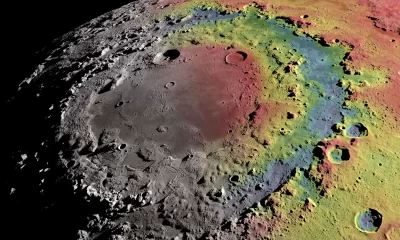Featured
Artemis Paving the Way for Mars | MOON
The Apollo missions placed the first steps on the Moon, but it is through the Artemis program that humanity will embark on an unprecedented journey of sustainable work and habitation on another world. Artemis, named after the Greek goddess of the Moon, represents the next chapter in human exploration, one that seeks to establish our lasting presence in the stars. As we venture beyond the boundaries of Earth, the lunar surface will serve as a proving ground, allowing us to learn, adapt, and prepare for the ultimate goal of reaching Mars.
The Importance of Artemis
Artemis holds immense importance in our quest for interplanetary exploration. It goes beyond the desire to set foot on new celestial bodies; it aims to unlock the potential of the Moon as a sustainable outpost for humanity. Through Artemis, we will learn how to live and work in the harsh lunar environment, developing the necessary technologies and methodologies to thrive on an alien world. This knowledge will be invaluable as we set our sights on Mars, a planet that presents even greater challenges and opportunities.
As the Man Peacefully Glides Along the Water: A Journey of Tranquility and Contemplation
Establishing Humanity’s Presence in the Stars
Artemis marks a significant milestone in human history, establishing our presence beyond Earth. By demonstrating our ability to sustainably inhabit the Moon, we are proving that we can extend our reach and adapt to the demands of extraterrestrial environments. This achievement will reshape our perspective and open up new possibilities for the future of humanity. It signifies a transition from short-term missions to a sustained presence, with the Moon acting as a stepping stone towards the far reaches of our solar system.
Preparing for Mars Exploration
The Vision of Artemis
The Artemis program represents a shared vision among NASA, international partners, and the scientific community. It is a collaborative effort that aims to not only push the boundaries of human exploration but also foster cooperation and unity among nations. Together, we envision a future where lunar missions become a global endeavor, where diverse perspectives and expertise converge to unlock the full potential of the Moon. This vision transcends borders, reminding us that our destiny lies not only on Earth but in the vast expanse of space.
Advancements in Technology and Science
Artemis is driving remarkable advancements in technology and science. The challenges posed by living on the Moon require innovative solutions, leading to the development of cutting-edge technologies that will have far-reaching benefits. From advanced life support systems to resource utilization techniques, the lessons learned from Artemis will not only enable sustained lunar missions but also find applications on Earth. The knowledge gained will enhance our understanding of life sciences, material science, robotics, and more, spurring advancements in various industries and sectors.
Overcoming Challenges
Sustained lunar missions and establishing a long-term presence on the Moon present numerous challenges. Radiation, extreme temperatures, limited resources, and the isolation of the lunar environment are just a few of the hurdles we must overcome. However, it is precisely these challenges that drive us to innovate and push the boundaries of human capability. By overcoming these obstacles, we pave the way for future generations to explore the cosmos, expanding our horizons and making the seemingly impossible possible.
Inspiring the Next Generation
Artemis has the power to inspire the next generation of explorers, scientists, and dreamers. By witnessing humanity’s achievements in space, young minds are sparked with curiosity and wonder, igniting a passion for science, technology, engineering, and mathematics (STEM). Artemis serves as a catalyst for innovation, motivating future generations to push the boundaries of human knowledge and explore uncharted territories. It is through their dreams and aspirations that humanity’s journey to the stars will continue long into the future.
Conclusion
As the Artemis program propels us toward a sustainable presence on the Moon, we stand on the precipice of an extraordinary era in human history. We are on the verge of unlocking the secrets of the cosmos and forging a new path for our species. Artemis represents our determination, resilience, and collective spirit as we venture beyond the familiar, guided by a desire to explore and understand. It is through endeavors like Artemis that we transcend the limits of our world and embark on a journey that will shape the destiny of humanity.
FAQs
1. How will Artemis help in preparing for Mars missions?
Artemis serves as a crucial stepping stone for Mars exploration. By utilizing the Moon as a testbed, we can develop and refine the necessary technologies, systems, and strategies needed for successful missions to Mars. The lessons learned from sustained lunar missions will provide invaluable insights, helping us mitigate risks and optimize our approach for the challenges that await us on the Red Planet.
2. What are the key goals of the Artemis program?
The Artemis program has several key goals, including establishing a sustainable human presence on the Moon, conducting scientific research, developing technologies for deep space exploration, fostering international collaboration, inspiring the next generation, and paving the way for eventual missions to Mars.
3. How will international collaboration be involved in Artemis missions?
International collaboration is a fundamental aspect of the Artemis program. NASA is actively engaging with international partners, including space agencies from other countries, to foster cooperation and share resources, knowledge, and expertise. This collaboration promotes a diverse and global approach to lunar exploration, ensuring that the benefits and challenges of Artemis missions are shared among nations.
4. What technological advancements are expected from the Artemis program?
The Artemis program is driving advancements in various fields, including space propulsion, robotics, life support systems, resource utilization, 3D printing, and communications. These technological developments will not only enable sustained lunar missions but also have broader applications on Earth, benefiting industries such as healthcare, manufacturing, and sustainable resource management.
5. How will Artemis inspire future generations to pursue space exploration?
Artemis has the potential to captivate and inspire the next generation. By witnessing humanity’s achievements in space, young minds are sparked with curiosity and a sense of wonder. Artemis serves as a symbol of human potential and ignites a passion for scientific discovery, technological innovation, and space exploration. It encourages young individuals to pursue careers in STEM fields, shaping the future of space exploration and expanding our understanding of the universe.
Monica Maakor Otumfuor an Alumni of Ghana Institute of Journalism is a Writer and English tutor by profession. A voice over artist and an articulate spokesperson. She loves to volunteer and is passionate about mentoring others.














